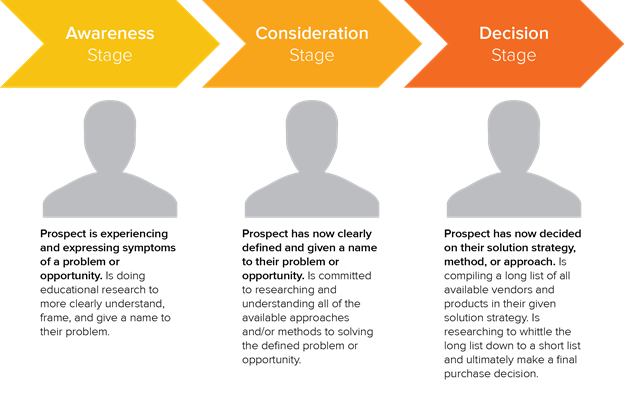One of the most fundamental concepts in modern marketing is the idea of the buyer’s journey. Taken at face value, it also happens to be one of the least useful ways to think about marketing and how marketing influences buying decisions.
Hot take alert? Maybe. But if you take the paradigm at face value, Marketers get left with only an extremely shallow understanding of the buying process.
And a shallow understanding of the buying process will lead to unfocused, uninteresting, and uninspired marketing work which will lead to bored, unengaged prospects that will never buy from you.
What makes the Buyer’s Journey so shallow as is?
Well first, let’s take a look at the Buyer’s Journey diagram from HubSpot:

Pretty useful for people who have never heard of marketing before, but for everyone else it is a little basic.
It is basic because it is a description of stages that a prospect goes through, but it does not model how and why they progress through the stages into the part where they buy your product.
What it is missing is a framework that models a customer’s actual, internal decision making process. To do that, we need to talk about the emotional component of all of these stages.
One thing to realize—all decisions are emotional in nature. If you think about the chaos that surrounds us in this crazy world, and you think about the amount of information that needs to be processed by our mind and our senses, it is a wonder we are able to parse the incomprehensibly large amount of raw data with our brains, and then make value judgements that turn into decisions.
Turns out, one way the mind does that is through the gift of our emotions.
So the goal here will be to take another look at the Buyer’s Journey, keep the three stages, and along the way consider the emotional aspects of the Buyer’s Journey.
The Awareness Stage: Prospects realize they have pain points
The awareness stage of the HubSpot Buyer's Journey is where customers realize they have a problem. The important word here is “realize”—it’s the word that actually gives us something to work with.
What does it mean to realize they have a problem?
The realization is usually the result of feeling a pain point. People that are not in pain usually don’t realize they have a problem.
But when they do realize it, it becomes pretty clear to them:
To be effective in this stage, you need to be acutely attuned to your customer's pain points. To do this, create a list of pain points that prompt your ideal customer to realize they have a problem.
Here are some common ones:
- They are spending too much time on something
- They are spending too much money on something
- They do not know how to do something
But the more specific you can get, the more powerful your messaging in this stage will be.
Here is how you do it:
Speak to customer pain point in the words used by customers
At this stage, before you even mention that you are selling a product, you want to make sure that your messaging matches the way your customers think of their problem. This created alignment between their intentions and your methods.
Identify the ways that buyers learn more about their pain point
Your company solves a specific problem for a specific type of person- the question in the Awareness stage is where do these people currently go to solve that problem? If you can find those places then you can reach those people.
Identify the stakes for the buyer
We all have a lot of problems, and most times we ignore them. For a buyer to take action their problem will need to be consequential enough that they will eventually buy your product to solve it. Outline the consequences of what happens when buyers ignore the problem you solve.
Relieve confusion about their problem
If a buyer has a problem and they are just realizing it, they probably don’t necessarily know much about their problem. They are experiencing a general pain point or a point of friction that needs to be overcome that prompts them to recognize that a problem is occurring.
But they still have a lot of questions that need to be answered and they might not even have identified the actual pain point that needs relieving. Help them in this stage by relieving their confusion and setting them on the right path.
Customers on the Awareness stage of the Buyer’s Journey by definition have the lowest buying intent, but present an opportunity to influence impressionable in-market prospects that you will be able to push further down the journey by speaking to the emotional notes of their pain points.
The Consideration Stage: Prospects have defined their problem
In the Consideration phase of the HubSpot Buyer's Journey, prospects are evaluating different solution types to their problems.
This is a stage when prospects are looking for guidance from someone they can trust. If you can become that resource, then you will have created an emotional bond and the prospect will be more likely to choose your category type and product.
But you will have to match your offer to their buyer’s stage. Offer them advice, offer them guidance, and offer them value first.
And do not ruin your relationship in this stage by trying to force them into a decision they do not feel ready for or you might come off as a sleazy salesman.
Which one do you trust more?
Here are some more general tips:
Define and advocate for the category of your solution
Customer problems are general. But your solution is specific. It belongs to a specific category of solutions that exists among other categories which could also solve their problem. Define the category of your solution and advocate for it so that customers know the angle of your solution and why it is the right choice for them and their problem.
Define the pros and cons of various solutions categories for your prospect
What makes a customer a good fit for your product but not a good fit for your competitor’s product? The more defined you are here the better.
Define how buyers decide their best fit solutions category
How do buyer’s discriminate between products—is it price, features, geography, demographics? Connect the way they discriminate between products to their emotional reasoning to speak to them in their own language.
The Decision Stage: Remember the emotions
Think about the last time you made the decision to buy something. Did you create a pros and cons list of every product that solved an issue in your problem area and then run a cost-benefit analysis that referenced the price and expected ROI of each platform?
If you said yes, I won’t believe you.
For many customers, the decision stage in the HubSpot Buyer's Journey looks more like this:
That is—the aimless compilation of both relevant and irrelevant information in our heads as we feed raw data into our emotions and intuition to guide our decisions ultimately resulting in a gut feeling.
We all like to think that we make decisions completely logically, but in reality, decision making is itself an arduous process. It is a period of being “in-between” states and so we rely on our emotions to get us as quickly to a Decision as possible. Whether you are selling T-shirts or B2B software, the job of you as a marketer is to create an emotional connection with your brand, often by making the Consideration phase as easy as possible for your prospect.
Here are some questions for you to ask yourself:
- What makes your product different than other products?
- Why should consumers choose your products over another product?
- What makes you more trustworthy?
- What makes your product better than your competitors?
Answer these questions from an emotional standpoint. What does your product do differently that will make the lives of its buyer better than the buyer of a different product- and how does that translate to emotional states?
By this point you should be feeling like a regular Sigmund Freud.
Conclusion
Never forget that we are selling to people and that people make decisions emotionally. Use your marketing to speak to your prospects emotional experiences based on their stage in theHubSpot Buyer's Journey and you will create valuable, memorable, timely, and helpful marketing that will put your brand ahead.
Written by:
Media JunctionRelated Topics:




